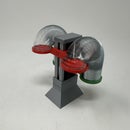Introduction: Two Air Pumps
Two Air Pumps are smaller 3D printed versions of much larger air / water pumps I built using PVC pipes and fittings when I was much younger. This design is somewhat similar (although inverse in operation) to the 3D printed single cylinder air engine (https://www.instructables.com/id/Single-Cylinder-Air-Engine-Smaller-Edition/) in that there is a single cylinder, a single piston, and dual openings for air intake. However, instead of having a moving valve plate either leading or lagging the piston by 90 degrees in order to control air flow through the dual pressure and exhaust ports, this design utilizes a much simpler valve, an o-ring on the piston itself, and a single exhaust port, the plunger stem.
I have included two versions of the air pump in Two Air Pumps, one short and one tall. The differences between the two (aside from one is shorter and one is taller) is the taller version is capable of moving more air per stroke than the shorter version, and as such requires fewer pumping cycles than the smaller version to move the equivalent amount of air. If you have a taller format printer, I recommend printing the taller version, however, the shorter version easily produces enough air to inflate the "punch balloons" I have used in Four Whistles Version 2 (https://www.instructables.com/id/Four-Whistles-Version-2/), Balloon Powered Single Cylinder Air Engine Open Chassis (https://www.instructables.com/id/Balloon-Powered-Single-Cylinder-Air-Engine-Open-Ch/) and Balloon Powered Single Cylinder Air Engine Toy Train (https://www.instructables.com/id/Balloon-Powered-Single-Cylinder-Air-Engine-Toy-Tra/).
Assembling either air pump is via threaded connections. One of the many items on my Autodesk Fusion360 "things to learn list" was to learn threads, so I incorporated threaded connections in this design for a more secure assembly. The threads printed great with no additional scaling or support material required for a good, air tight fit.
In order to complete this model, you will need to purchase an "AS568 #222" o-ring (1 1/2" ID, 1 3/4" OD, 1/8" section), flexible gasket material (I've used thick cardboard, inner tubes, thick rubber gloves, silicon baking sheets and 1.5mm thick shelf liner, I liked the shelf liner the best) and petroleum jelly (for lubrication of the o-ring piston valve). I also used scissors, a single bevel razor blade, a modeling knife, and a needle file set for assembly.
And as usual, I probably forgot a file or two or who knows what else, so if you have any questions, please do not hesitate to ask as I do make mistakes in plenty.
Designed using Autodesk Fusion 360, sliced using Cura 2.3.1, and printed in PLA on an Ultimaker 2+ Extended and an Ultimaker 3 Extended.
Step 1: Purchase, Print and Prepare the Parts.
As mentioned, I have included two versions of the air pump in Two Air Pumps, short and tall. Select either the combination of "Plunger.stl and Tube.stl", or "Plunger Tall.stl and Tube Tall.stl" that best fits your printer. The remaining parts fit either configuration.
I printed all parts on an Ultimaker 2+ Extended and an Ultimaker 3 Extended at .1mm vertical resolution for the tall version, .2mm vertical resolution for the short version, 50% infill for both, and no supports. At both .1mm and .2mm vertical resolution, both air pumps assembled and operated fine so printing at .2mm will reduce printing time.
Prior to assembly, test fit and trim, file, sand, etc. all parts as necessary for smooth movement of moving surfaces, and tight fit for non moving surfaces. Depending on the colors you chose and your printer settings, more or less trimming, filing and/or sanding may be required. Carefully file all edges that contacted the build plate to make absolutely sure that all build plate "ooze" is removed and that all edges are smooth. I used a flat jewelers file and plenty of patience to perform this step. To minimize filing, printing with the slicer "brim" or "raft" feature is a good option.
Use "Gasket Template.stl" to cut the air intake gaskets from the gasket material of your choosing. I used both a single bevel razor blade and a modeling knife to cut the gaskets. Make sure the cut is clean before attempting to remove the waste material. Note that one gasket has a center hole, and the other does not. The center hole gasket is for the plunger end of the air pump, and the remaining gasket is for the remaining end.
Attachments
Step 2: Assemble the Air Pump.
After printing and preparing all the parts, and cutting the air intake gaskets, assemble the air pump as shown in the video.
Hope you like it!

Participated in the
Design Now: In Motion Contest
























